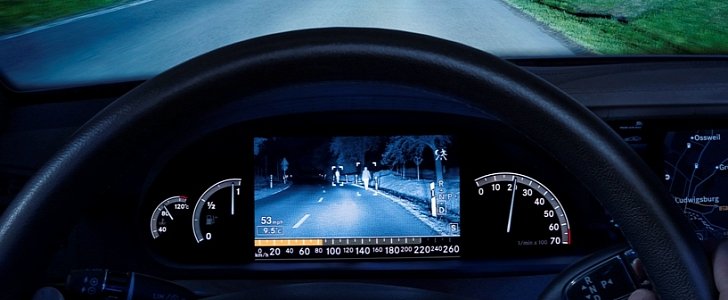Night Vision technology, the gadget first introduced by premium carmakers like Mercedes-Benz over 15 years ago, will have to change its ways to become useful.
While the technology has evolved and is becoming mainstream, the system relies on the driver to take action when something out of the ordinary is spotted.
Analysts from ABI Research, a company specialized in the technology market, say that the tech needs to adapt to the requirements of self-driving cars, or it will perish.
The researchers at ABI estimate that all new cars on the market in 2022 will have a more useful system as standard - autonomous emergency braking. Unlike night vision, the former will have the ability to act when an imminent impact is detected.
As Tech Crunch notes, the way night vision technology works in current cars is called VUD, for Vulnerable User Detection. The term refers to the system’s need for a human operator to react to stimuli, a task that might be skipped because of our nature.
In other words, even at the height of night vision technology, the system relies on human attention. Augmenting human perception is useless when the operator is not as attentive as a robot, researchers say.
While scanning for potential hazards at the side of the road is a good safety feature, especially in poorly lit environments, the system is perfectible through the aid of automated driving technology.
According to ABI Research, the future of night vision is implementation on self-driving vehicles. This category of cars can benefit the most from a technology that watches the side of the road for unpredictable hazard factors, like deer or pedestrians. Instead of notifying the driver, the system will notify the self-driving system, which will be prepared to take action.
Furthermore, in the world of inter-connected self-driving vehicles, this system could be used to map potential hazards and warn other incoming cars of potential danger. Once several cars pass through the area and the potential risk is no longer present, the alert disappears from the command system of other autonomous vehicles.
Analysts from ABI Research, a company specialized in the technology market, say that the tech needs to adapt to the requirements of self-driving cars, or it will perish.
The researchers at ABI estimate that all new cars on the market in 2022 will have a more useful system as standard - autonomous emergency braking. Unlike night vision, the former will have the ability to act when an imminent impact is detected.
As Tech Crunch notes, the way night vision technology works in current cars is called VUD, for Vulnerable User Detection. The term refers to the system’s need for a human operator to react to stimuli, a task that might be skipped because of our nature.
In other words, even at the height of night vision technology, the system relies on human attention. Augmenting human perception is useless when the operator is not as attentive as a robot, researchers say.
While scanning for potential hazards at the side of the road is a good safety feature, especially in poorly lit environments, the system is perfectible through the aid of automated driving technology.
According to ABI Research, the future of night vision is implementation on self-driving vehicles. This category of cars can benefit the most from a technology that watches the side of the road for unpredictable hazard factors, like deer or pedestrians. Instead of notifying the driver, the system will notify the self-driving system, which will be prepared to take action.
Furthermore, in the world of inter-connected self-driving vehicles, this system could be used to map potential hazards and warn other incoming cars of potential danger. Once several cars pass through the area and the potential risk is no longer present, the alert disappears from the command system of other autonomous vehicles.

